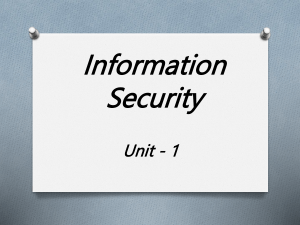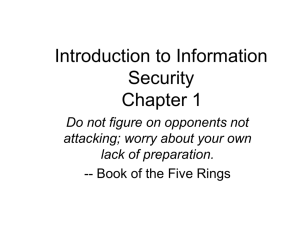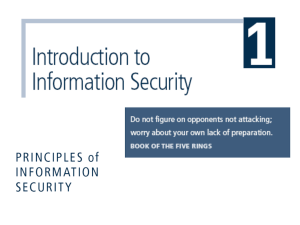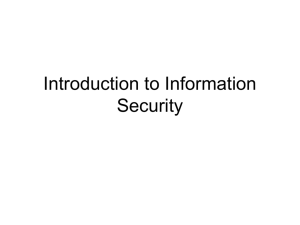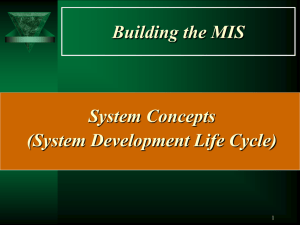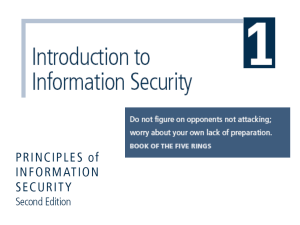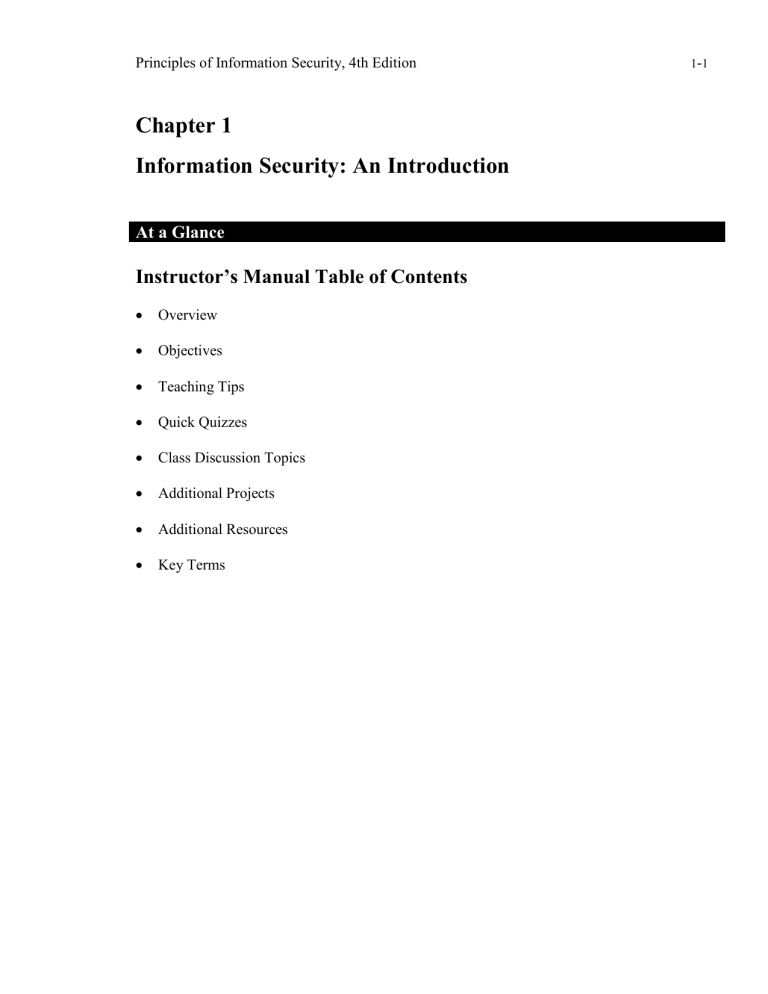
Principles of Information Security, 4th Edition Chapter 1 Information Security: An Introduction At a Glance Instructor’s Manual Table of Contents Overview Objectives Teaching Tips Quick Quizzes Class Discussion Topics Additional Projects Additional Resources Key Terms 1-1 Principles of Information Security, 4th Edition 1-2 Lecture Notes Overview This opening chapter establishes the foundation for understanding the broader field of information security. This is accomplished by defining key terms, explaining essential concepts, and reviewing the origins of the field and its impact on the understanding of information security. Chapter Objectives In this chapter, your students will learn to: Define information security Recount the history of computer security, and explain how it evolved into information security Define key terms and critical concepts of information security Enumerate the phases of the security systems development life cycle Describe the information security roles of professionals within an organization Teaching Tips Introduction 1. Explain that information security in today’s enterprise is a “well-informed sense of assurance that the information risks and controls are in balance.” Jim Anderson, Inovant (2002) 2. Before we can begin analyzing the details of information security, it is necessary to review the origins of this field and its impact on our understanding of information security today. The History of Information Security 1. Emphasize that the need for computer security, or the need to secure the physical location of hardware from outside threats, began almost immediately after the first mainframes were developed. 2. Note that groups developing code-breaking computations during World War II created the first modern computers. 3. Describe how badges, keys, and facial recognition of authorized personnel controlled access to sensitive military locations. 4. Explain how in contrast, information security during these early years was rudimentary and mainly composed of simple document classification schemes. Principles of Information Security, 4th Edition 1-3 5. Discuss why there was no application classification projects for computers or operating systems at this time, because the primary threats to security were physical theft of equipment, espionage against the products of the systems, and sabotage. The 1960s 1. Explain that during the 1960s, the Department of Defense’s Advanced Research Procurement Agency (ARPA) began examining the feasibility of a redundant networked communications system designed to support the military’s need to exchange information. 2. Identify Larry Roberts, who is known as the founder of the Internet, developed the project from its inception. The 1970s and 80s 1. Explain that during the next decade, the ARPANET grew in popularity and use, and so did its potential for misuse. 2. Emphasize that in December of 1973, Robert M. Metcalfe indicated that there were fundamental problems with ARPANET security. 3. Explain that individual remote users’ sites did not have sufficient controls and safeguards to protect data against unauthorized remote users. 4. Dicuss the lack of safety procedures for dial-up connections to the ARPANET. 5. Explain that user identification and authorization to the system were nonexistent. 6. Describe how phone numbers were widely distributed and openly publicized on the walls of restrooms and phone booths, giving hackers easy access to ARPANET. Teaching Tip Students often perceive the historical material as dry and uninteresting. Focus on the visible and exciting aspects, such as the enigma machine, the rise of the Internet as an outshoot of the Cold War (ARPA was a DOD organization), and the espionage ramifications of the need for security at this stage of the evolution of computer science. Many students are drawn to the topics of system penetration (hacking) or the use of forensics tools and procedures in solving crimes, and these ‘hooks’ may be useful to draw the students into the material. 7. Explain that the movement toward security went beyond protecting physical locations and began with the Rand Report R-609. This was sponsored by the Department of Defense, which attempted to define multiple controls and mechanisms necessary for the protection of a multilevel computer system. Principles of Information Security, 4th Edition 1-4 8. Discuss how the scope of computer security grew from physical security to include: Safety of the data itself Limiting of random and unauthorized access to that data Involvement of personnel from multiple levels of the organization 9. Note that at this stage, the concept of computer security evolved into the more sophisticated system we call information security. MULTICS 1. Explain that much of the focus for research on computer security centered on a system called MULTICS (Multiplexed Information and Computing Service). 2. Point out that in mid-1969, not long after the restructuring of the MULTICS project, several of the key players created a new operating system called UNIX. 3. Explain that while the MULTICS system had planned security with multiple security levels and passwords, the UNIX system did not. 4. Emphasize that in the late 1970s, the microprocessor brought in a new age of computing capabilities and security threats as these microprocessors were networked. The 1990s 1. Discuss that at the close of the 20th century, as networks of computers became more common, so too did the need to connect the networks to each other. This gave rise to the Internet, the first manifestation of a global network of networks. 2. Explain that there has been a price for the phenomenal growth of the Internet, however. When security was considered at all, early Internet deployment treated it as a low priority. 3. Note that as the requirement for networked computers became the dominant style of computing, the ability to physically secure the physical computer was lost, and the stored information became more exposed to security threats. 2000 to Present 1. Discuss how today, the Internet has brought millions of unsecured computer networks into communication with each other. 2. Explain that our ability to secure each computer’s stored information is now influenced by the security on each computer to which it is connected. Principles of Information Security, 4th Edition Teaching Tip 1-5 A concrete example or demonstration might be useful at this point. Using a classroom computer with a projector, show how easy it is to connect as a peer to a Windows computer with file sharing turned on. Quick Quiz 1 1. What does ARPA stand for? Answer: The Department of Defense's Advanced Research Project Agency 2. Which DoD report attempted to define the multiple control mechanisms necessary for the protection of a multilevel computer system? Answer: The Rand Report R-609 3. True or False: MULTICS is a now obsolete operating system designed for security objectives. Answer: True What is Security? 1. Explain that in general, security is “the quality or state of being secure—to be free from danger.” It means to be protected from adversaries, from those who would do harm, intentionally or otherwise. 2. Discuss how a successful organization should have the following multiple layers of security in place for the protection of its operations: Physical security to protect the physical items, objects, or areas of an organization from unauthorized access and misuse Personal security to protect the individual or group of individuals who are authorized to access the organization and its operations Operations security to protect the details of a particular operation or series of activities Communications security to protect an organization’s communications media, technology, and content Network security to protect networking components, connections, and contents Information security to protect information assets 3. Explain that information security, therefore, is the protection of information and its critical elements, including the systems and hardware that use, store, and transmit that information. However, to protect the information and its related systems from danger, tools, such as policy, awareness, training, education, and technology, are necessary. Principles of Information Security, 4th Edition 1-6 4. Discuss the C.I.A. triangle, which has been considered the industry standard for computer security since the development of the mainframe. It was solely based on three characteristics that described the utility of information: confidentiality, integrity, and availability. The C.I.A. triangle has expanded into a list of critical characteristics of information. Critical Characteristics of Information 1. Emphasize that the value of information comes from the characteristics it possesses: Availability enables users who need to access information to do so without interference or obstruction and to retrieve that information in the required format. Accuracy occurs when information is free from mistakes or errors and has the value that the end user expects. If information contains a value different from the user’s expectations due to the intentional or unintentional modification of its content, it is no longer accurate. Authenticity is the quality or state of being genuine or original, rather than a reproduction or fabrication. Information is authentic when it is the information that was originally created, placed, stored, or transferred. Confidentiality is the quality or state of preventing disclosure or exposure to unauthorized individuals or systems. Integrity is the quality or state of being whole, complete, and uncorrupted. The integrity of information is threatened when the information is exposed to corruption, damage, destruction, or other disruption of its authentic state. Utility is the quality or state of having value for some purpose or end. Information has value when it serves a particular purpose. This means that if information is available, but not in a format meaningful to the end user, it is not useful. Possession is the quality or state of having ownership or control of some object or item. Information is said to be in one's possession if one obtains it, independent of format or other characteristics. While a breach of confidentiality always results in a breach of possession, a breach of possession does not always result in a breach of confidentiality. CNSS Security Model 1. Discuss the security model, as represented in Figure 1-6 on page 16, and show the three dimensions. If you extrapolate the three dimensions of each axis, you end up with a 3 × 3 × 3 cube with 27 cells representing areas that must be addressed to secure the information systems of today. Your primary responsibility is to make sure that each of the 27 cells is properly addressed during the security process. Teaching Tip You can direct students to the National Training Standard for Information Security Professionals at http://www.cnss.gov/Assets/pdf/nstissi_4011.pdf for more detailed information about minimum training requirements for INFOSEC professionals. Principles of Information Security, 4th Edition 1-7 Components of an Information System 1. Explain that to fully understand the importance of information security, it is necessary to briefly review the elements of an information system. An information system (IS) is much more than computer hardware; it is the entire set of software, hardware, data, people, procedures, and networks necessary to use information as a resource in the organization. Software 1. Explain that software is the operating systems, applications, and assorted utilities of an information system. Hardware 1. Define hardware as the physical assets that run the applications that manipulate the data of an information system. As hardware has become more portable, the threat posed by hardware loss has become a more prominent problem. Data 1. Explain that the lifeblood of an organization is the information needed to strategically execute on business opportunities and the data processed by information systems are critical to today’s business strategy. People 1. Note that people are often the weakest link in an information system, since they give the orders, design the systems, develop the systems, and ultimately use and game the systems that run today’s business world. Procedures 1. Explain that procedures are the written instructions for accomplishing a task, which may include the use of technology or information systems, but not necessarily. These are the rules that we are supposed to follow and the foundation for the technical controls that security systems must be designed to implement. Networks 1. Emphasize that the modern information processing system is extremely complex and relies on many hundreds of connections, both internal and external. From the LAN to the MAN and ultimately the WAN or Internet, networks are the highway over which information systems pass data and users complete their tasks. 2. Explain that proper control over all traffic in every network in an organization is vital to properly managing the information flow and security of that organization. Principles of Information Security, 4th Edition Teaching Tip 1-8 For an alternative view of the components of an information system, from the business perspective, refer students to this MBA view at http://www.mbaknol.com/management-information-systems/components-of-aninformation-system/ Quick Quiz 2 1. True or False: Personal security addresses the issues needed to protect items, objects, or areas. Answer: False 2. ____ security addresses the protection of individuals or groups authorized to access an organization. a. Public b. Personnel c. Physical d. Personal Answer: D 3. ____ security encompasses the protection of an organization's communications media, technology, and content. Answer: Communications 4. Ownership or control of information is called the characteristic of _____. a. confidentiality b. possession c. authenticity d. integrity Answer: B 5. True or False: If information has a state of being genuine or original and is not a fabrication, it has the characteristic of authenticity. Answer: True 6. The characteristic of information that deals with preventing disclosure is ______. Answer: confidentiality Balancing Information Security and Access 1. Discuss that when considering information security, it is important to realize that it is impossible to obtain perfect security. Security is not an absolute; it is a process and not a goal. Security should be considered a balance between protection and availability. To achieve balance, the level of security must allow reasonable access, yet protect against threats. Principles of Information Security, 4th Edition 1-9 Approaches to Information Security Implementation 1. Explain that security can begin as a grassroots effort when systems administrators attempt to improve the security of their systems. This is referred to as the bottom-up approach. 2. Discuss the key advantage of the bottom-up approach, which is the technical expertise of the individual administrators. Unfortunately, this approach seldom works, as it lacks a number of critical features, such as participant support and organizational staying power. 3. Explain that an alternative approach, which has a higher probability of success, is called the top-down approach. The project is initiated by upper management who issue policy, procedures, and processes, dictate the goals and expected outcomes of the project, and determine who is accountable for each of the required actions. 4. Explain that the top-down approach has strong upper-management support, a dedicated champion, dedicated funding, clear planning, and the opportunity to influence organizational culture. 5. Discuss the most successful top-down approach involves a formal development strategy referred to as a systems development life cycle. The Systems Development Life Cycle 1. Note that information security must be managed in a manner similar to any other major system implemented in the organization. 2. Explain that the best approach for implementing an information security system in an organization with little or no formal security in place is to use a variation of the systems development life cycle (SDLC): the security systems development life cycle (SecSDLC). Teaching Tip To get an overview of security and the SDLC, consider the following paper from SANS http://www.giac.org/resources/whitepaper/application/442.pdf and also have students look over the NIST special publication 800-53 (http://csrc.nist.gov/publications/nistpubs/800-53-Rev2/sp800-53-rev2-final.pdf). Methodology and Phases 1. Explain that the SDLC is a methodology for the design and implementation of an information system in an organization. Principles of Information Security, 4th Edition 1-10 2. Discuss that a methodology is a formal approach to solving a problem based on a structured sequence of procedures. Using a methodology ensures a rigorous process and avoids missing those steps that can lead to compromising the end goal. The goal is to create a comprehensive security posture. 3. Describe how the entire process may be initiated in response to specific conditions or combinations of conditions. 4. Explain that the impetus to begin the SecSDLC may be event-driven, started in response to some occurrence, or plan-driven as a result of a carefully developed implementation strategy. 5. Discuss the structured review that comes at the end of each phase is also known as a “reality check,” during which the team determines if the project should be continued, discontinued, outsourced, or postponed until additional expertise or organizational knowledge is acquired. Investigation 1. Discuss why the first phase, investigation, is the most important. What is the problem the system is being developed to solve? This phase begins with an examination of the event or plan that initiates the process. 2. Explain that the objectives, constraints, and scope of the project are specified. A preliminary cost/benefit analysis is developed to evaluate the perceived benefits and the appropriate levels of cost an organization is willing to expend to obtain those benefits. 3. Note that a feasibility analysis is performed to assess the economic, technical, and behavioral feasibilities of the process and to ensure that implementation is worth the organization’s time and effort. Analysis 1. Explain that the analysis phase begins with the information learned during the investigation phase. This phase consists primarily of assessments of the organization, the status of current systems, and the capability to support the proposed systems. 2. Emphasize that analysts begin to determine what the new system is expected to do and how it will interact with existing systems. The phase ends with the documentation of the findings and a feasibility analysis update. Logical Design 1. Explain that in the logical design phase, the information gained from the analysis phase is used to begin creating a solution system for a business problem. 2. Explain that the next step is selecting applications capable of providing needed services based on the business need. Based on the applications needed, data support and structures capable of providing the needed inputs are selected. Principles of Information Security, 4th Edition 1-11 3. Finally, based on all of the above, specific technologies are selected to implement the physical solution. In the end, another feasibility analysis is performed. Physical Design 1. Explain that during the physical design phase, specific technologies are selected to support the alternatives identified and evaluated in the logical design. 2. Discuss how the selected components are evaluated based on a make-or-buy decision (develop in-house or purchase from a vendor). 3. Note that final designs integrate various components and technologies. 4. Explain that after yet another feasibility analysis, the entire solution is presented to the end-user representatives for approval. Implementation 1. Describe how in the implementation phase, any needed software is created. Components are ordered, received, and tested. 2. Explain that afterwards, users are trained and supporting documentation is created. Again, a feasibility analysis is prepared, and the users are presented with the system for a performance review and acceptance test. Maintenance and Change 1. Discuss the maintenance and change phase and explain that it is the longest and most expensive phase of the process. This phase consists of the tasks necessary to support and modify the system for the remainder of its useful life cycle. 2. Explain that even though formal development may conclude during this phase, the life cycle of the project continues until it is determined that the process should begin again from the investigation phase. When the current system can no longer support the changed mission of the organization, the project is terminated and a new project is implemented. Teaching Tip It may be useful to have a Q&A-type approach because many students may have been exposed to SA&D methodologies. Try asking for a show of hands of who has been trained in SA&D, and then follow up with a show of fingers as to how many phases were in the methodology. Other comparisons of approach can also be used. Principles of Information Security, 4th Edition 1-12 Securing the SDLC 1. Explain that each of the phases of the SDLC should include consideration of the security of the system being assembled as well as the information it uses. Such consideration means that each implementation of a system is secure and does not risk compromising the confidentiality, integrity, and availability of the organization’s information assets. 2. Note that NIST recommends that organizations incorporate the associated IT security steps of the included general SDLC into their development processes. (See textbook pages 23-25) It is imperative that information security be designed into a system from its inception, rather than added in during or after the implementation phase. 3. Point out that organizations are moving toward more security-focused development approaches, seeking to improve not only the functionality of the systems they have in place, but the confidence of the consumer in their product. The Security Systems Development Life Cycle 1. Explain that the same phases used in the traditional SDLC can be adapted to support the specialized implementation of a security project. 2. Emphasize that the fundamental process is the identification of specific threats and the creation of specific controls to counter those threats. The SecSDLC unifies the process and makes it a coherent program rather than a series of random, seemingly unconnected actions. Investigation 1. Explain that the investigation of the SecSDLC begins with a directive from upper management, dictating the process, outcomes, and goals of the project, as well as the constraints placed on the activity. Frequently, this phase begins with an enterprise information security policy (EISP) that outlines the implementation of security. 2. Discuss how the teams of responsible managers, employees, and contractors are organized; problems are analyzed; and the scope is defined, including goals, objectives, and constraints not covered in the program policy. 3. Explain that an organizational feasibility analysis is performed to determine whether the organization has the resources and commitment necessary to conduct a successful security analysis and design. Principles of Information Security, 4th Edition 1-13 Analysis 1. Explain that in the analysis phase, the documents from the investigation phase are studied. The development team conducts a preliminary analysis of existing security policies or programs, along with documented current threats and associated controls. 2. Discuss that this phase also includes an analysis of relevant legal issues that could impact the design of the security solution. 3. Emphasize that the risk management task—identifying, assessing, and evaluating the levels of risk facing the organization—also begins in this stage. Logical Design 1. Explain that the logical design phase creates and develops the blueprints for security and examines and implements key policies that influence later decisions. 2. Note that also at this stage, critical planning is developed for incident response actions to be taken in the event of partial or catastrophic loss. 3. Explain that a feasibility analysis determines whether or not the project should continue or be outsourced. Physical Design 1. Discuss that in the physical design phase, the security technology needed to support the blueprint outlined in the logical design is evaluated, alternative solutions are generated, and a final design is agreed upon. 2. Emphasize that the security blueprint may be revisited to keep it synchronized with the changes needed when the physical design is completed. 3. Discuss the criteria needed to determine the definition of successful solutions is also prepared during this phase. 4. Explain that included at this time are the designs for physical security measures to support the proposed technological solutions. 5. Note that at the end of this phase, a feasibility study should determine the readiness of the organization for the proposed project, and then the champion and users are presented with the design. At this time, all parties involved have a chance to approve the project before implementation begins. Implementation 1. Explain that the implementation phase is similar to the traditional SDLC. 2. Discuss how security solutions are acquired (made or bought), tested, implemented, and tested again. Principles of Information Security, 4th Edition 1-14 3. Emphasize that personnel issues are evaluated and specific training and education programs are conducted. 4. Explain that the entire tested package is presented to upper management for final approval. Maintenance and Change 1. Discuss why the maintenance and change phase, though last, is perhaps the most important, given the high level of ingenuity in today’s threats. 2. Explain that the reparation and restoration of information is a constant duel with an often unseen adversary. 3. Emphasize that as new threats emerge and old threats evolve, the information security profile of an organization requires constant adaptation to prevent threats from successfully penetrating sensitive data. Teaching Tip Discuss with students alternative software development life cycles, such as AGILE and how Microsoft has developed a secure development life cycle while retaining their AGILE methodology. Quick Quiz 3 1. True or False: Information security programs that begin at a grassroots level by system administrators to improve security are often called a bottom-up approach. Answer: True 2. When projects are initiated at the highest levels of an organization and then pushed to all levels, they are said to follow a(n) ____ approach. a. executive led b. trickle down c. top-down d. bottom-up Answer: C 3. A formal approach to solving a problem based on a structured sequence of procedures is called a(n) _____. Answer: SDLC methodology 4. Which SecSDLC phase keeps the security systems in a high state of readiness? Answer: Maintenance and Change Principles of Information Security, 4th Edition 1-15 Security Professionals and the Organization 1. Explain that it takes a wide range of professionals to support a diverse information security program. 2. Note that to develop and execute specific security policies and procedures, additional administrative support and technical expertise is required. Senior Management 1. Explain that the Chief Information Officer is the senior technology officer, although other titles such as vice president of information, VP of information technology, and VP of systems may also be used. The CIO is primarily responsible for advising the chief executive officer, president, or company owner on the strategic planning that affects the management of information in the organization. 2. Explain that the Chief Information Security Officer is the individual primarily responsible for the assessment, management, and implementation of securing the information in the organization. The CISO may also be referred to as the manager for security, the security administrator, or a similar title. Information Security Project Team 1. Discuss the individuals who comprise the project team and explain that they are experienced in one or multiple facets of the required technical and nontechnical areas. Champion: A senior executive who promotes the project and ensures its support, both financially and administratively, at the highest levels of the organization. Team leader: A project manager, who may be a departmental line manager or staff unit manager, who understands project management, personnel management, and information security technical requirements. Security policy developers: Individuals who understand the organizational culture, policies, and requirements for developing and implementing successful policies. Risk assessment specialists: Individuals who understand financial risk assessment techniques, the value of organizational assets, and the security methods to be used. Security professionals: Dedicated, trained, and well-educated specialists in all aspects of information security from both a technical and nontechnical standpoint. Systems administrators: Individuals whose primary responsibility is administering the systems that house the information used by the organization. End users: Those whom the new system will most directly impact. Ideally, a selection of users from various departments, levels, and degrees of technical knowledge assist the team in focusing on the application of realistic controls applied in ways that do not disrupt the essential business activities they seek to safeguard. Principles of Information Security, 4th Edition 1-16 Data Responsibilities 1. Discuss and define the roles of those who own and safeguard the data. Data Owners: Those responsible for the security and use of a particular set of information. Data owners usually determine the level of data classification associated with the data, as well as changes to that classification required by organizational change. Data Custodians: Those responsible for the storage, maintenance, and protection of the information. The duties of a data custodian often include overseeing data storage and backups, implementing the specific procedures and policies laid out in the security policies and plans, and reporting to the data owner. Data Users: End users who work with the information to perform their daily jobs supporting the mission of the organization. Everyone in the organization is responsible for the security of data, so data users are included here as individuals with an information security role. Communities of Interest 1. Explain that each organization develops and maintains its own unique culture and values. Within each organizational culture, there are communities of interest. As defined here, a community of interest is a group of individuals who are united by similar interests or values within an organization and who share a common goal of helping the organization to meet its objectives. 2. Note that there can be many different communities of interest in an organization. The three that are most often encountered, and which have roles and responsibilities in information security, are listed here. In theory, each role must complement the other but this is often not the case. Information Security Management and Professionals 1. Explain that these professionals are focused on protecting the organization’s information systems and stored information from attacks. Information Technology Management and Professionals 1. Discuss why technology managers often focus on operating the technology operations with a focus on cost and not necessarily on security. 2. Explain that the goals of the IT community and the information security community are not always in complete alignment, and depending on the organizational structure, this may cause conflict. Organizational Management and Professionals 1. Note that both IT and information security professionals must remind themselves that they are here to serve and support this community. Principles of Information Security, 4th Edition 1-17 2. Explain that a secure system is not useful to an organization if the business goals of the organization cannot be furthered. Teaching Tip In many classroom settings, there are often students already employed full time in IT. Volunteer “testimonials” about real-life experiences can be useful and interesting. Information Security: Is it an Art or a Science? 1. Explain that with the level of complexity in today’s information systems, the implementation of information security has often been described as a combination of art and science. 2. Discuss the concept of the “security artisan” and explain that it is based on the way individuals have perceived systems technologists since computers became commonplace. Security as Art 1. Explain that there are no hard and fast rules regulating the installation of various security mechanisms, nor are there many universally accepted complete solutions. 2. Explain that while there are many manuals to support individual systems, once these systems are interconnected, there is no magic user’s manual for the security of the entire system. This is especially true with the complex levels of interaction between users, policy, and technology controls. Security as Science 1. Explain that we are dealing with technology developed by computer scientists and engineers—technology designed to operate at rigorous levels of performance. 2. Note that even with the complexity of the technology, most scientists would agree that specific scientific conditions cause virtually all actions that occur in computer systems. Almost every fault, security hole, and systems malfunction is a result of the interaction of specific hardware and software. 3. Explain that if developers had sufficient time, they could resolve and eliminate these faults. Security as a Social Science 1. Introduce a third view: security as a social science. 2. Explain that social science examines the behavior of individuals as they interact with systems, whether societal systems or, in our case, information systems. Principles of Information Security, 4th Edition 1-18 3. Discuss that security begins and ends with the people inside the organization and the people that interact with the system, planned or otherwise. 4. Note that end users who need the very information the security personnel are trying to protect may be the weakest link in the security chain. 5. Explain that by understanding some of the behavioral aspects of organizational science and change management, security administrators can greatly reduce the levels of risk caused by end users, and they can create more acceptable and supportable security profiles. Teaching Tip Student interaction is often a good way to solidify learning. Try breaking the class into three teams. Have each team spend five minutes planning an argument to support one of the three approaches to information security (art, science, or social science), and then have a representative from each group argue their point to the whole class. Quick Quiz 4 1. A senior executive who promotes an information security project and ensures its support, both financially and administratively, at the highest levels of the organization is called a(n) _____. Answer: champion 2. True or False: The person responsible for the storage, maintenance, and protection of the information is the data custodian. Answer: True 3. What are the three most commonly encountered communities of interest that have roles and responsibilities in information security? Answer: Information security management and professionals, information technology management and professionals, organizational management and professionals 4. True or False: With the level of complexity in today’s information systems, the implementation of information security has often been described as a combination of art and technology. Answer: False 5. _____ examines the behavior of individuals as they interact with systems, whether societal systems or information systems. a. Community science b. Social science c. Societal science d. Interaction management Principles of Information Security, 4th Edition 1-19 Answer: B Class Discussion Topics 1. What is the defining difference between computer security and information security? 2. Why can we argue that information security is really an application of social science? Additional Projects 1. Using the World Wide Web, find a recent feature article about a CISO or other IT professional with CISO job functions. Write a short summary of that individual and how he or she came to hold that position. The publications ComputerWorld and Information Week often have these kinds of features. 2. Using a library with current periodicals, find a recent news article about a topic related to information security. Write a one- to two-page review of the article and how it is related to the principles of information security introduced in the textbook. Additional Resources 1. Internet Society – Histories of the Internet http://www.isoc.org/internet/history/brief.shtml 2. CNSS National Information Assurance Glossary http://www.isoc.org/internet/history/brief.shtml 3. Microsoft Security Development Lifecycle http://www.microsoft.com/security/sdl/ 4. What is a Chief Security Officer http://www.csoonline.com/article/221739/what-is-a-chief-security-officer- Key Terms Access: a subject or object’s ability to use, manipulate, modify, or affect another subject or object. Accuracy: when information is free from mistakes or errors and it has the value that the end user expects. Asset: the organizational resource that is being protected; can be logical, such as a Web site, information, or data; or physical, such as a person, computer system, or other tangible object. Principles of Information Security, 4th Edition 1-20 Attack: an intentional or unintentional act that can cause damage to or otherwise compromise information and/or the systems that support it; can be active or passive, intentional or unintentional, and direct or indirect. Authenticity of information: the quality or state of being genuine or original, rather than a reproduction or fabrication. Availability: enables authorized users—persons or computer systems—to access information without interference or obstruction and to receive it in the required format. Bottom-up approach: a grassroots effort in which systems administrators attempt to improve the security of their systems. C.I.A. triangle: the industry standard for computer security since the development of the mainframe. Champion: a senior executive who promotes the project and ensures its support, both financially and administratively, at the highest levels of the organization. Chief information officer (CIO): the senior technology officer. Chief information security officer (CISO): has primary responsibility for the assessment, management, and implementation of information security in the organization. Communications security: protects communications media, technology, and content. Community of interest: a group of individuals who are united by similar interests or values within an organization and who share a common goal of helping the organization to meet its objectives. Computer security: the need to secure physical locations, hardware, and software from threats. Confidentiality: when information is protected from disclosure or exposure to unauthorized individuals or systems. Control, safeguard, or countermeasure: security mechanisms, policies, or procedures that can successfully counter attacks, reduce risk, resolve vulnerabilities, and otherwise improve the security within an organization. Data custodians: working directly with data owners, data custodians are responsible for the storage, maintenance, and protection of the information. Data owners: those responsible for the security and use of a particular set of information. Data users: end users who work with the information to perform their assigned roles supporting the mission of the organization. E-mail spoofing: the act of sending an e-mail message with a modified field. End users: those whom the new system will most directly affect. Enterprise information security policy (EISP): outlines the implementation of a security program within the organization. Exploit: a technique used to compromise a system; can be a verb or a noun; make use of existing software tools or custom-made software components. Exposure: a condition or state of being exposed; in information security, exposure exists when a vulnerability known to an attacker is present. File hashing: method of assuring information integrity of a file is read by a special algorithm that uses the value of the bits in the file to compute a single large number. Hash value: a single large number used in file hashing. Information security project team: should consist of a number of individuals who are experienced in one or multiple facets of the required technical and nontechnical areas. Information security: to protect the confidentiality, integrity and availability of information assets, whether in storage, processing or transmission. Principles of Information Security, 4th Edition 1-21 Integrity: when information is whole, complete, and uncorrupted. Loss: a single instance of an information asset suffering damage or unintended or unauthorized modification or disclosure. When an organization’s information is stolen, it has suffered a loss. McCumber Cube: provides a graphical representation of the architectural approach widely used in computer and information security. Methodology: a formal approach to solving a problem by means of a structured sequence of procedures. Network security: to protect networking components, connections, and contents. Operations security: to protect the details of a particular operation or series of activities. Organizational culture: unique culture and values of an organization. Personnel security: to protect the individual or group of individuals who are authorized to access the organization and its operations. Phishing: when an attacker attempts to obtain personal or financial information using fraudulent means. Physical security: to protect physical items, objects, or areas from unauthorized access and misuse. Possession of information: the quality or state of ownership or control. Protection profile or security posture: the entire set of controls and safeguards, including policy, education, training and awareness, and technology, that the organization implements (or fails to implement) to protect the asset. Risk assessment specialists: people who understand financial risk assessment techniques, the value of organizational assets, and the security methods to be used. Risk management: the process of identifying, assessing, and evaluating the levels of risk facing the organization, specifically the threats to the organization’s security and to the information stored and processed by the organization. Risk: the probability that something unwanted will happen; organizations must minimize risk to match their risk appetite—the quantity and nature of risk the organization is willing to accept. Salami theft: occurs when an employee steals a few pieces of information at a time, knowing that taking more would be noticed—but eventually the employee gets something complete or useable. Security policy developers: people who understand the organizational culture, existing policies, and requirements for developing and implementing successful policies. Security professionals: dedicated, trained, and well-educated specialists in all aspects of information security from both a technical and nontechnical standpoint. Subjects and objects: a computer can be either the subject of an attack—an agent entity used to conduct the attack—and/or the object of an attack—the target entity, as shown in Figure 1-5 Systems administrators: people with the primary responsibility for administering the systems that house the information used by the organization. Systems development life cycle (SDLC): a methodology for the design and implementation of an information system. Team leader: a project manager, who may be a departmental line manager or staff unit manager, who understands project management, personnel management, and information security technical requirements. Threat agent: the specific instance or a component of a threat. For example, all hackers in the world present a collective threat, while Kevin Mitnick, who was convicted for Principles of Information Security, 4th Edition 1-22 hacking into phone systems, is a specific threat agent. Likewise, a lightning strike, hailstorm, or tornado is a threat agent that is part of the threat of severe storms. Threat: a category of objects, persons, or other entities that presents a danger to an asset; always present and can be purposeful or undirected. Top-down approach: effort in which the security project is initiated by upper-level managers who issue policy, procedures and processes, dictate the goals and expected outcomes, and determine accountability for each required action—has a higher probability of success. Utility of information: the quality or state of having value for some purpose or end. Information has value when it can serve a purpose. Vulnerability: a weakness or fault in a system or protection mechanism that opens it to attack or damage. Examples of vulnerabilities are a flaw in a software package, an unprotected system port, and an unlocked door. Some well-known vulnerabilities have been examined, documented, and published; others remain latent (or undiscovered). Waterfall model: each phase begins with the results and information gained from the previous phase.

